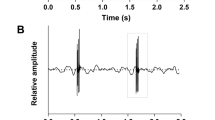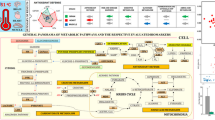Summary
The burrow-dwelling woodchuck (Marmota monax) (mean body wt.=4.45±1 kg) was compared to a similar-sized (5.87±1.5 kg) but arboreal rodent, the porcupine (Erithrizon dorsatum), in terms of its ventilatory and heart rate responses to hypoxia and hypercapnia, and its blood characteristics.V T,f,T I andT E were measured by whole-body plethysmography in four awake individuals of each species. The woodchuck has a longerT E/T TOT (0.76±0.03) than the porcupine (0.61±0.03). The woodchuck had a higher threshold and significantly smaller slope to its CO2 ventilatory response compared to the porcupine, but showed no difference in its hypoxic ventilatory response. The woodchuck P50 of 27.8 was hardly different from the porcupine value of 30.7, but the Bohr factor, −0.72, was greater than the porcupine's, −0.413. The woodchuck breathing air has PaCO2=48 (±2) torr, PaO2=72 (±6), pHa=7.357 (±0.01); the porcupine blood gases are PaCO2=34.6 (±2.8), PaO2=94.9 (±5), pHa=7.419 (±0.03), suggesting a difference in PaCO2/pH set points. The woodchuck exhibited no reduction in heart rate with hypoxia, nor did it have the low normoxic heart rate observed in other burrowing mammals.
Similar content being viewed by others
References
Albers C (1961) Der Mechanismus des Wärmehechelns beim Hund III. Die CO2-Empfindlichkeit des Atemzentrums während des Wärmehechelns. Pflügers Arch 274:166–183
Ar A, Arieli R, Shkolnik A (1977) Blood-gas properties and function in the fossorial mole rat under normal and hypoxic-hypercapnic atmospheric conditions. Respir Physiol 30:201–218
Arieli R, Ar A (1979) Ventilation of a fossorial mammal (Spalax ehrenbergi) in hypoxic and hypercapnic conditions. J Appl Physiol: REEP 47:1011–1017
Arieli R, Ar A (1981) Heart rate responses of the mole rat (Spalax ehrenbergi) in hypercapnic hypoxic and cold conditions. Physiol Zool 54:14–21
Bartlett D, Tenney SM (1970) Control of breathing in experimental anemia. Respir Physiol 10:384–395
Birchard GF, Boggs DF, Tenney SM (1984) Effects of perinatal CO2 exposure on adult ventilatory responses. Respir Physiol 57:341–347
Boggs DF, Birchard GF (1983) Relationship between hemoglobin O2 affinity and hypoxic ventilatory response in the rhea and pheasant. J Exp Biol 102:347–352
Boggs DF, Kilgore DL Jr, Birchard GF (1984) Respiratory physiology of burrowing mammals and birds. Comp Biochem Physiol 77A:107
Boggs DF, Tenney SM (1984) Scaling respiratory pattern and respiratory ‘drive’. Respir Physiol 58:245–252
Bowes G, Andrey SM, Kozar LF, Phillipson EA (1982) Role of the carotid chemoreceptors in regulation of inspiratory onset. J Appl Physiol: REEP 52:863–868
Burlington RF, Maher JT, Sidel CM (1969) Effect of hypoxia on blood gases, acid-base balance and in vitro myocardial function in a hibernator and a non-hibernator. Fed Proc 28:1042–1046
Burlington RF, Vogel JA, Burton TM, Solkoritz IA (1971) Cardiac output and regional blood flow in hypoxic woodchucks. Am J Physiol 220:1565–1568
Chapin JL (1954) Ventilatory response of the unrestrained and unanesthetized hamster to CO2. Am J Physiol 179:146–148
Darden TR (1972) Respiratory adaptations of a fossorial mammal, the pocket gopher (Thomomys bottae). J Comp Physiol 78:121–137
Edwards MS, Martin RS (1966) Mixing techniques for the oxygen-hemoglobin equilibrium and Bohr effect. J Appl Physiol 21:1898–1902
Gautier H, Remmers JE, Bartlett Jr D (1973) Control of the duration of expiration. Respir Physiol 18:205–221
Hall FG (1965) Hemoglobin and Oxygen: Affinities in seven species of Sciuridae. Science 148:1350–1351
Haywood D, Bloete M (1969) Respiratory responses of healthy young women to CO2 inhalation. J Appl Physiol 27:32–35
Irving L (1938) Insensitivity of diving animals to CO2. Am J Physiol 124:729–734
Johansen K, Lykkeboe G, Weber RE, Maloiy GMO (1976) Blood respiratory properties in the naked mole rat,Heterocephalus glaber, a mammal of low body temperature. Respir Physiol 28:303–314
Klein JP, Forster HV, Biscard GE, Kaminski RP, Pan LG, Hamilton LH (1982) Ventilatory response to inspired CO2 in normal and carotid body devernated ponies. J Appl Physiol 52:1614–1622
Lapennas GW (1983) The magnitude of the Bohr coefficient: optimal for oxygen delivery. Respir Physiol
Messier A, Schaefer KE (1973) The Bohr effect in chronic hypercapnea. Respir Physiol 19:26–34
Milsom WK, McArthur MD, Webb CL (1986) Control of breathing in hibernating ground squirrels. In: Heller HC, Musacchia XJ, Wang LH (eds) Living in the cold. Elsevier Press, New York, pp 469–475
Mithoefer JC, Kazemi H (1964) Effect of carbon dioxide on heart rate. J Appl Physiol 19:1151–1156
Parer JT, Hodson WA (1974) Respiratory studies of monotremes IV. Normal respiratory functions of echidnas and ventilatory response to inspired oxygen and carbon dioxide. Respir Physiol 21:307–316
Parer JT, Metcalfe J (1967) Respiratory studies of monotremes III. Blood gas transport and hemodynamics in the unanesthetized echidna. Respir Physiol 3:151–159
Schaefer KE (1958) Respiratory pattern and respiratory response to CO2. J Appl Physiol 13:1–14
Schlenker EH (1985) Ventilation and metabolism of the Djungarian Hamster (Phodopus sungorus) and the Albino Mouse. Comp Biochem Physiol 82A:293–295
Schmidt-Nielsen K, Larimer JL (1958) Oxygen dissociation curves of mammalian blood in relation to size. Am J Physiol 5:424–428
Simpson GC, Roe A, Lewontin RC (1960) Quantitative zoology. Harcourt, Brace and World, New York
Soholt LF, Yousef MK, Dill DB (1973) Responses of Merriam's kangaroo rats,Dipodomys merriami to various levels of carbon dioxide concentration. Comp Biochem Physiol 45A:455–462
Sokal RR, Rohlf FJ (1969) Biometry. WH Freeman, San Francisco, pp 220–221
Stahl WR (1967) Scaling of respiratory variables in mammals. J Appl Physiol 22:453–460
Tenney SM, Boggs DF (1986) Comparative mammalian respiratory control. In: Handbook of physiology, Sect 3: The respiratory system Vol II: Control of breathing. Cherniack NS, Widdicombe JG (eds) Am Physiol Soc, Bethesda, Md., pp 833–855
Van Nice P, Black CP, Tenney SM (1980) A comparative study of ventilatory responses to hypoxia with reference to hemoglobin O2 affinity in llama, cat, rat, duck and goose. Comp Biochem Physiol 44A:347–350
Ward SA, Drysdale DB, Cunningham DJC, Petersen ES (1979) Inspiratory-expiratory responses to alternate-breath oscillation of PACO2 and PAO2. Respir Physiol 36:311–325
Walker BR, Adams EM, Voelkel NF (1985) Ventilatory responses of hamsters and rats to hypoxia and hypercapnia. J Appl Physiol 59:1955–1960
Williams DD, Rausch RL (1973) Seasonal carbon dioxide and oxygen concentrations in the dens of hibernating mammals (Sciuridae). Comp Biochem Physiol 44A:1227–1235
Author information
Authors and Affiliations
Rights and permissions
About this article
Cite this article
Boggs, D.F., Birchard, G.F. Cardiorespiratory responses of the woodchuck and porcupine to CO2 and hypoxia. J Comp Physiol B 159, 641–648 (1989). https://doi.org/10.1007/BF00694390
Accepted:
Issue Date:
DOI: https://doi.org/10.1007/BF00694390




